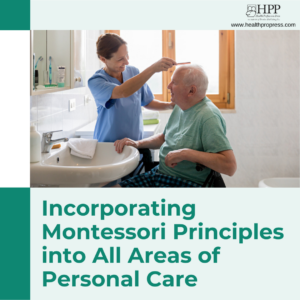
Implementing Modifications in the Care Community
Environmental interventions and modifications may require approval and/or funding to implement. When requesting funding from a supervisor or the administrator of your care community, here are a few things to keep in mind.
The importance of environment
Research has shown that communication is impacted by the environment, and that modifications improve communication skills in individuals with dementia. Unfortunately, poorly designed environmental features often contribute to unsatisfactory responses or behaviors in individuals with cognitive impairment. As individuals age, there are changes in cognition, memory, language, vision, and hearing. Therefore, it is necessary that the living environment adapt to optimize cognitive, visual, and auditory aspects.
It is important to assess the public and personal spaces in your care community and make changes or modifications based on what you find. (See Environment and Communication Assessment Toolkit for Dementia Care to learn more about assessing the environment.)
Higher quality of life for the residents
The main argument for making environmental modifications to support effective communication is that they can lead to less disability, easier communication between residents and staff, and fewer challenging behaviors that occur as a result of miscommunication. All of these can be viewed as components of a higher quality of life for the residents. More effective communication also leads to better quality of care, because staff and residents can understand each other more easily. Quality of care and quality of life are, fundamentally, the main goals of any care community.
Money talks
Especially when you are asking to implement something that costs money, you need to be able to demonstrate that it will save money in the long run. This is called a return on investment, or ROI. There are several ways that spending money on environmental interventions to support effective communication can result in a positive ROI. Improving communication between residents and therapists can support residents’ progress toward therapy goals. Therapy is stopped when no progress is seen, and this is often a result of a poor communication environment causing excess disability in individuals with dementia. Modifications that improve communication, such as additional acoustic treatment to reduce background noise in the therapy rooms/areas, will enable therapists to offer therapy for longer periods of time to residents with dementia. This results in higher reimbursement, and is especially applicable for residents on Part B therapy services.
Provide backup
Cite research studies and results. Some of the research studies demonstrate improved ROI. For example, improving the environment in the dining room has been shown to increase both more effective communication and more independence in eating, and in one study increased caloric intake by 1000 Kcal over a three-day calorie count. This can reduce the need for expensive supplements.
Another impact of environmental enhancements is improved staff efficacy from less time spent in unnecessary caregiving tasks such as identifying the toilet or resident’s bedroom. While this is unlikely to reduce the number of staff, it may result in less staff stress, allowing staff to spend more time interacting with residents on a more meaningful level.
Remember…YOU are the expert
Realistically, there will be times when your request for some modification does not get approved for financial reasons. Don’t despair. By making a strong and logical argument for important changes, you are letting your supervisor and administrator know that you have special knowledge and that, sometime in the future when environmental modifications are being considered, you can provide valuable input into the design process. Many architects and interior designers are not familiar with the needs and ability of individuals with dementia—YOU are the expert.
This post was adapted from Environment and Communication Assessment Toolkit (ECAT) for Dementia Care by Jennifer Brush, Margaret Calkins, Carrie Bruce, and Jon Sanford, Copyright © 2012 by I.D.E.A.S., Inc. All rights reserved.
Read the book!
 Environment & Communication Assessment Toolkit (ECAT™) for Dementia Care
Environment & Communication Assessment Toolkit (ECAT™) for Dementia Care
By Jennifer Brush, M.A., CCC-SLP, Margaret Calkins, Ph.D., CAPS, EDAC, Carrie Bruce, M.A., CCC-SLP, ATP, and Jon Sanford, M.Arch.
Copyright © 2012 by I.D.E.A.S., Inc.
With this innovative toolkit, identify simple changes you can make in the care environment to drastically improve everyday functioning of people with dementia—light and sound meters included!





Add comment